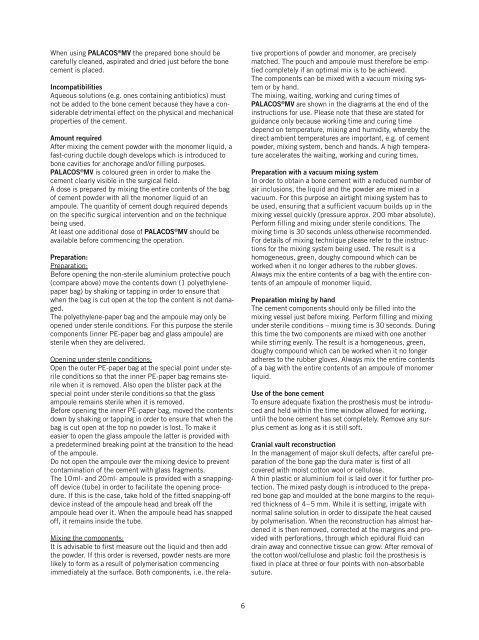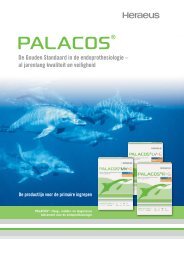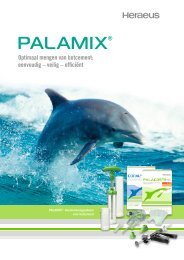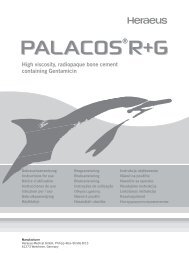Medium viscosity radiopaque bone cement
Medium viscosity, radiopaque bone cement - Heraeus Medical
Medium viscosity, radiopaque bone cement - Heraeus Medical
Create successful ePaper yourself
Turn your PDF publications into a flip-book with our unique Google optimized e-Paper software.
When using PALACOS ® MV the prepared <strong>bone</strong> should be<br />
carefully cleaned, aspirated and dried just before the <strong>bone</strong><br />
<strong>cement</strong> is placed.<br />
Incompatibilities<br />
Aqueous solutions (e.g. ones containing antibiotics) must<br />
not be added to the <strong>bone</strong> <strong>cement</strong> because they have a considerable<br />
detrimental effect on the physical and mechanical<br />
properties of the <strong>cement</strong>.<br />
Amount required<br />
After mixing the <strong>cement</strong> powder with the monomer liquid, a<br />
fast-curing ductile dough develops which is introduced to<br />
<strong>bone</strong> cavities for anchorage and/or filling purposes.<br />
PALACOS ® MV is coloured green in order to make the<br />
<strong>cement</strong> clearly visible in the surgical field.<br />
A dose is prepared by mixing the entire contents of the bag<br />
of <strong>cement</strong> powder with all the monomer liquid of an<br />
ampoule. The quantity of <strong>cement</strong> dough required depends<br />
on the specific surgical intervention and on the technique<br />
being used.<br />
At least one additional dose of PALACOS ® MV should be<br />
available before commencing the operation.<br />
Preparation:<br />
Preparation:<br />
Before opening the non-sterile aluminium protective pouch<br />
(compare above) move the contents down (1 polyethylenepaper<br />
bag) by shaking or tapping in order to ensure that<br />
when the bag is cut open at the top the content is not damaged.<br />
The polyethylene-paper bag and the ampoule may only be<br />
opened under sterile conditions. For this purpose the sterile<br />
components (inner PE-paper bag and glass ampoule) are<br />
sterile when they are delivered.<br />
Opening under sterile conditions:<br />
Open the outer PE-paper bag at the special point under sterile<br />
conditions so that the inner PE-paper bag remains sterile<br />
when it is removed. Also open the blister pack at the<br />
special point under sterile conditions so that the glass<br />
ampoule remains sterile when it is removed.<br />
Before opening the inner PE-paper bag, moved the contents<br />
down by shaking or tapping in order to ensure that when the<br />
bag is cut open at the top no powder is lost. To make it<br />
easier to open the glass ampoule the latter is provided with<br />
a predetermined breaking point at the transition to the head<br />
of the ampoule.<br />
Do not open the ampoule over the mixing device to prevent<br />
contamination of the <strong>cement</strong> with glass fragments.<br />
The 10ml- and 20ml- ampoule is provided with a snappingoff<br />
device (tube) in order to facilitate the opening procedure.<br />
If this is the case, take hold of the fitted snapping-off<br />
device instead of the ampoule head and break off the<br />
ampoule head over it. When the ampoule head has snapped<br />
off, it remains inside the tube.<br />
Mixing the components:<br />
It is advisable to first measure out the liquid and then add<br />
the powder. If this order is reversed, powder nests are more<br />
likely to form as a result of polymerisation commencing<br />
immediately at the surface. Both components, i.e. the relative<br />
proportions of powder and monomer, are precisely<br />
matched. The pouch and ampoule must therefore be emptied<br />
completely if an optimal mix is to be achieved.<br />
The components can be mixed with a vacuum mixing system<br />
or by hand.<br />
The mixing, waiting, working and curing times of<br />
PALACOS ® MV are shown in the diagrams at the end of the<br />
instructions for use. Please note that these are stated for<br />
guidance only because working time and curing time<br />
depend on temperature, mixing and humidity, whereby the<br />
direct ambient temperatures are important, e.g. of <strong>cement</strong><br />
powder, mixing system, bench and hands. A high temperature<br />
accelerates the waiting, working and curing times.<br />
Preparation with a vacuum mixing system<br />
In order to obtain a <strong>bone</strong> <strong>cement</strong> with a reduced number of<br />
air inclusions, the liquid and the powder are mixed in a<br />
vacuum. For this purpose an airtight mixing system has to<br />
be used, ensuring that a sufficient vacuum builds up in the<br />
mixing vessel quickly (pressure approx. 200 mbar absolute).<br />
Perform filling and mixing under sterile conditions. The<br />
mixing time is 30 seconds unless otherwise recommended.<br />
For details of mixing technique please refer to the instructions<br />
for the mixing system being used. The result is a<br />
homogeneous, green, doughy compound which can be<br />
worked when it no longer adheres to the rubber gloves.<br />
Always mix the entire contents of a bag with the entire contents<br />
of an ampoule of monomer liquid.<br />
Preparation mixing by hand<br />
The <strong>cement</strong> components should only be filled into the<br />
mixing vessel just before mixing. Perform filling and mixing<br />
under sterile conditions – mixing time is 30 seconds. During<br />
this time the two components are mixed with one another<br />
while stirring evenly. The result is a homogeneous, green,<br />
doughy compound which can be worked when it no longer<br />
adheres to the rubber gloves. Always mix the entire contents<br />
of a bag with the entire contents of an ampoule of monomer<br />
liquid.<br />
Use of the <strong>bone</strong> <strong>cement</strong><br />
To ensure adequate fixation the prosthesis must be introduced<br />
and held within the time window allowed for working,<br />
until the <strong>bone</strong> <strong>cement</strong> has set completely. Remove any surplus<br />
<strong>cement</strong> as long as it is still soft.<br />
Cranial vault reconstruction<br />
In the management of major skull defects, after careful preparation<br />
of the <strong>bone</strong> gap the dura mater is first of all<br />
covered with moist cotton wool or cellulose.<br />
A thin plastic or aluminium foil is laid over it for further protection.<br />
The mixed pasty dough is introduced to the prepared<br />
<strong>bone</strong> gap and moulded at the <strong>bone</strong> margins to the required<br />
thickness of 4–5 mm. While it is setting, irrigate with<br />
normal saline solution in order to dissipate the heat caused<br />
by polymerisation. When the reconstruction has almost hardened<br />
it is then removed, corrected at the margins and provided<br />
with perforations, through which epidural fluid can<br />
drain away and connective tissue can grow. After removal of<br />
the cotton wool/cellulose and plastic foil the prosthesis is<br />
fixed in place at three or four points with non-absorbable<br />
suture.<br />
6






